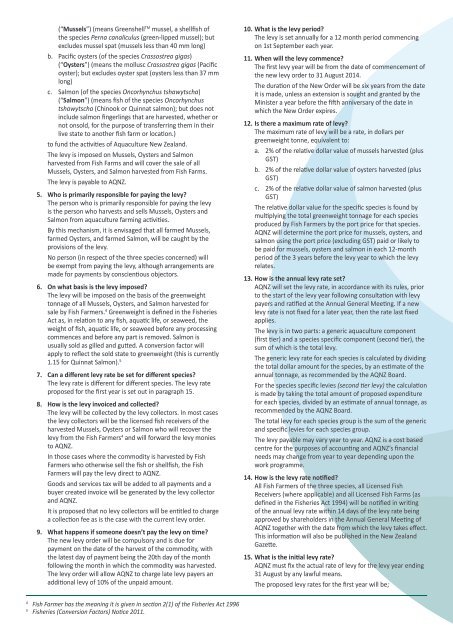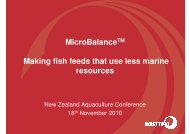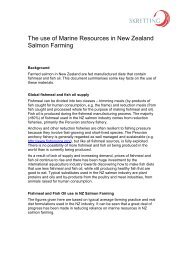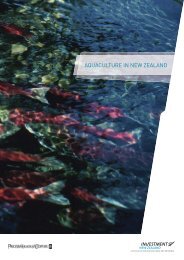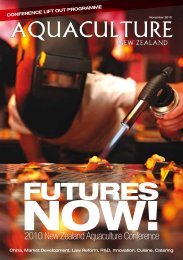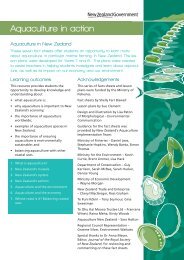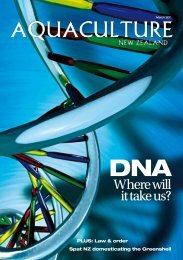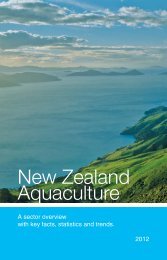Aquaculture New Zealand Commodity Levy Information Booklet
Aquaculture New Zealand Commodity Levy Information Booklet
Aquaculture New Zealand Commodity Levy Information Booklet
Create successful ePaper yourself
Turn your PDF publications into a flip-book with our unique Google optimized e-Paper software.
(“Mussels”) (means Greenshell TM mussel, a shellfish ofthe species Perna canaliculus (green-lipped mussel); butexcludes mussel spat (mussels less than 40 mm long)b. Pacific oysters (of the species Crassostrea gigas)(“Oysters”) (means the mollusc Crassostrea gigas (Pacificoyster); but excludes oyster spat (oysters less than 37 mmlong)c. Salmon (of the species Oncorhynchus tshawytscha)(“Salmon”) (means fish of the species Oncorhynchustshawytscha (Chinook or Quinnat salmon); but does notinclude salmon fingerlings that are harvested, whether ornot onsold, for the purpose of transferring them in theirlive state to another fish farm or location.)to fund the activities of <strong>Aquaculture</strong> <strong>New</strong> <strong>Zealand</strong>.The levy is imposed on Mussels, Oysters and Salmonharvested from Fish Farms and will cover the sale of allMussels, Oysters, and Salmon harvested from Fish Farms.The levy is payable to AQNZ.5. Who is primarily responsible for paying the levy?The person who is primarily responsible for paying the levyis the person who harvests and sells Mussels, Oysters andSalmon from aquaculture farming activities.By this mechanism, it is envisaged that all farmed Mussels,farmed Oysters, and farmed Salmon, will be caught by theprovisions of the levy.No person (in respect of the three species concerned) willbe exempt from paying the levy, although arrangements aremade for payments by conscientious objectors.6. On what basis is the levy imposed?The levy will be imposed on the basis of the greenweighttonnage of all Mussels, Oysters, and Salmon harvested forsale by Fish Farmers. 4 Greenweight is defined in the FisheriesAct as, in relation to any fish, aquatic life, or seaweed, theweight of fish, aquatic life, or seaweed before any processingcommences and before any part is removed. Salmon isusually sold as gilled and gutted. A conversion factor willapply to reflect the sold state to greenweight (this is currently1.15 for Quinnat Salmon). 57. Can a different levy rate be set for different species?The levy rate is different for different species. The levy rateproposed for the first year is set out in paragraph 15.8. How is the levy invoiced and collected?The levy will be collected by the levy collectors. In most casesthe levy collectors will be the licensed fish receivers of theharvested Mussels, Oysters or Salmon who will recover thelevy from the Fish Farmers 4 and will forward the levy moniesto AQNZ.In those cases where the commodity is harvested by FishFarmers who otherwise sell the fish or shellfish, the FishFarmers will pay the levy direct to AQNZ.Goods and services tax will be added to all payments and abuyer created invoice will be generated by the levy collectorand AQNZ.It is proposed that no levy collectors will be entitled to chargea collection fee as is the case with the current levy order.9. What happens if someone doesn’t pay the levy on time?The new levy order will be compulsory and is due forpayment on the date of the harvest of the commodity, withthe latest day of payment being the 20th day of the monthfollowing the month in which the commodity was harvested.The levy order will allow AQNZ to charge late levy payers anadditional levy of 10% of the unpaid amount.10. What is the levy period?The levy is set annually for a 12 month period commencingon 1st September each year.11. When will the levy commence?The first levy year will be from the date of commencement ofthe new levy order to 31 August 2014.The duration of the <strong>New</strong> Order will be six years from the dateit is made, unless an extension is sought and granted by theMinister a year before the fifth anniversary of the date inwhich the <strong>New</strong> Order expires.12. Is there a maximum rate of levy?The maximum rate of levy will be a rate, in dollars pergreenweight tonne, equivalent to:a. 2% of the relative dollar value of mussels harvested (plusGST)b. 2% of the relative dollar value of oysters harvested (plusGST)c. 2% of the relative dollar value of salmon harvested (plusGST)The relative dollar value for the specific species is found bymultiplying the total greenweight tonnage for each speciesproduced by Fish Farmers by the port price for that species.AQNZ will determine the port price for mussels, oysters, andsalmon using the port price (excluding GST) paid or likely tobe paid for mussels, oysters and salmon in each 12-monthperiod of the 3 years before the levy year to which the levyrelates.13. How is the annual levy rate set?AQNZ will set the levy rate, in accordance with its rules, priorto the start of the levy year following consultation with levypayers and ratified at the Annual General Meeting. If a newlevy rate is not fixed for a later year, then the rate last fixedapplies.The levy is in two parts: a generic aquaculture component(first tier) and a species specific component (second tier), thesum of which is the total levy.The generic levy rate for each species is calculated by dividingthe total dollar amount for the species, by an estimate of theannual tonnage, as recommended by the AQNZ Board.For the species specific levies (second tier levy) the calculationis made by taking the total amount of proposed expenditurefor each species, divided by an estimate of annual tonnage, asrecommended by the AQNZ Board.The total levy for each species group is the sum of the genericand specific levies for each species group.The levy payable may vary year to year. AQNZ is a cost basedcentre for the purposes of accounting and AQNZ’s financialneeds may change from year to year depending upon thework programme.14. How is the levy rate notified?All Fish Farmers of the three species, all Licensed FishReceivers (where applicable) and all Licensed Fish Farms (asdefined in the Fisheries Act 1994) will be notified in writingof the annual levy rate within 14 days of the levy rate beingapproved by shareholders in the Annual General Meeting ofAQNZ together with the date from which the levy takes effect.This information will also be published in the <strong>New</strong> <strong>Zealand</strong>Gazette.15. What is the initial levy rate?AQNZ must fix the actual rate of levy for the levy year ending31 August by any lawful means.The proposed levy rates for the first year will be;4Fish Farmer has the meaning it is given in section 2(1) of the Fisheries Act 19965Fisheries (Conversion Factors) Notice 2011.


